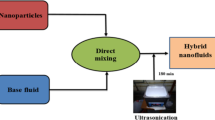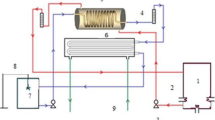Abstract
Nano-fluids are used to improve the heat transfer rates in heat exchangers, especially; the shell-and-tube heat exchanger that is considered one of the most important types of heat exchangers. In the present study, an experimental loop is constructed to study the thermal characteristics of the shell-and-tube heat exchanger; at different concentrations of Al2O3 nonmetallic particles (0.0, 2, 4, and 6 %). This material concentrations is by volume concentrations in pure water as a base fluid. The effects of nano-fluid concentrations on the performance of shell and tube heat exchanger have been conducted based on the overall heat transfer coefficient, the friction factor, the pressure drop in tube side, and the entropy generation rate. The experimental results show that; the highest heat transfer coefficient is obtained at a nano-fluid concentration of 4 % of the shell side. In shell side the maximum percentage increase in the overall heat transfer coefficient has reached 29.8 % for a nano-fluid concentration of 4 %, relative to the case of the base fluid (water) at the same tube side Reynolds number. However; in the tube side the maximum relative increase in pressure drop has recorded the values of 12, 28 and 48 % for a nano-material concentration of 2, 4 and 6 %, respectively, relative to the case without nano-fluid, at an approximate value of 56,000 for Reynolds number. The entropy generation reduces with increasing the nonmetallic particle volume fraction of the same flow rates. For increase the nonmetallic particle volume fraction from 0.0 to 6 % the rate of entropy generation decrease by 10 %.









Similar content being viewed by others
Abbreviations
- A:
-
Area of heat transfer (m2)
- Cp :
-
Specific heat capacity [J/(kg °C)]
- d:
-
Tube diameter (m)
- D:
-
Shell diameter (m)
- f:
-
Friction factor
- h:
-
Heat transfer coefficient [W/(m2 °C)]
- k:
-
Thermal conductivity [W/(m2 °C)]
- LMTD:
-
Logarithmic mean temperature difference (°C)
- \(\dot{m}\) :
-
Mass flow rate (kg/s)
- Q:
-
Rate of heat transfer (W)
- \(\dot{S}_{gen}\) :
-
Total entropy generation rate
- T:
-
Temperature (°C)
- U:
-
Overall heat transfer coefficient [W/(m2 °C)]
- μ:
-
Dynamic viscosity (N s/m2)
- ρ:
-
Density (kg/m3)
- ψ v :
-
Volume fraction
- ψ m :
-
Mass fraction
- bf :
-
Base fluid
- c, in :
-
Inlet cooling water
- c, out :
-
Outlet cooling water
- h, out :
-
Outlet hot nano-fluid
- h, in :
-
Inlet hot nano-fluid
- i :
-
Inner
- nf :
-
Nano-fluid
- np :
-
Nano-particle
- o :
-
Outlet
- sa :
-
Surface area
- ss :
-
Shell side surface
References
Nagy E, Feczko T, Koroknai B (2007) Enhancement of oxygen mass transfer rate in the presence of nanosized particles. Chem Eng Sci 62:7391–7398
Sara ON, Icer F, Yapici S, Sahin B (2011) Effect of suspended CuO nanoparticles on mass transfer to a rotating disc electrode. Exp Therm Fluid Sci 35:558–564
Ma X, Su F, Chen J, Bai T, Han Z (2009) Enhancement of bubble absorption process using a CNTs-ammonia binary nanofluid. Int Commun Heat Mass Transf 36:657–660
Namburu PK, Kulkarni DP, Misra D, Das DK (2007) Viscosity of copper oxide nanoparticles dispersed in ethylene glycol and water mixture. Exp Therm Fluid Sci 32:397–402
Darzi AAR, Farhadi M, Sedighi K, Shafaghat R, Zabihi K (2012) Experimental investigation of turbulent heat transfer and flow characteristics of SiO2/water nanofluid within helically corrugated tubes. Int Commun Heat Mass Transf 39(9):1425–1434
Wang X, Xu X, Choi US (1999) Thermal conductivity of nano particlese fluid mixture. J Thermophys Heat Transf 13(4):474–480
Eastman JA, Choi SU, Li S, Soyez G, Thompson LJ, DiMelfi RJ (1999) Novel thermal properties of nano-structured materials. J Metastab Nanocrystalline Mater 2(6):629–634
Raja M, Arunachalam RM, Suresh S (2012) Experimental studies on heat transfer of alumina/water nanofluid in a shell and tube heat exchanger with wire coil insert. Int J Mech Mater Eng 7(1):16–23
Rahman MM, Billah MM, Hasanuzzaman M, Saidur R, Rahim NA (2012) Heat transfer enhancement of nanofluid in a lid-driven square enclosure. Numer Heat Transf Part A Appl 62(12):973–991
Lotfi R, Rashidi AM, Amrorollahi A (2012) Experimental study on the heat transfer enhancement of MWNT-water nanofluid in a shell and tube heat exchanger. Int Commun Heat Mass Transf 39(1):108–111
Kleinstreuer C, Feng Y (2011) Experimental and theoretical studies of nanofluid thermal conductivity enhancement: a review. Nanoscale Res Lett 6(1):229
Timofeeva EV, Yu W, France DM, Singh D, Routbort JL (2011) Nanofluids for heat transfer: an engineering approach. Nanoscale Res Lett 6(1):1–7
Yu W, France DM, Routbort JL, Choi SUS (2008) Review and comparison of nanofluid thermal conductivity and heat transfer enhancements. Heat Transf Eng 29(5):432–460
Xie H, Wang J, Xi T, Liu Y, Ai F, Wu Q (2002) Thermal conductivity enhancement of suspensions containing nanosized alumina particles. J Appl Phys 91:4568
Kakac S, Parmuanjaroenkij A (2009) Review of convective heat transfer enhancement with nanofluids. Int J Mass Heat Transf 52(13):3187–3196
Elias MM, Miqdad M, Mahbuul IM, Saidur R, Kaamalisarvestani M, Sohel MR, Hepbasli A, Rahim NA, Amalina MA (2013) Effect of nanoparticle shape on the heat transfer and thermodynamic performance of a shell and tube heat exchanger. Int Commun Heat Mass Transf 44:93–99
Vakili M, Mohebbi A, Hashemipour H (2013) Experimental study on convective heat transfer of TiO2 nanofluids. Heat Mass Transf 49:1159–1165
Wang Y, Liu Z, Huang S, Liu W, Li W (2011) Experimental investigation of shell-and-tube heat exchanger with a new type of baffles. Heat Mass Transf 47:833–839
Wang L, Huang X-H, Zhen L (2004) Immiscible two-component two-phase gas–liquid heat transfer on shell side of a TEMA-F heat exchanger. Heat Mass Transf 40:301–306
In Cheol B, Soon HC (2005) Boiling heat transfer performance and phenomena of Al2O3-water nano-fluids from a plain surface in a pool. Int J Heat Mass Transf 48:2407–2419
Kern DQ (1984) Process heat transfer. McGraw-Hill, New York
Bougriou C, Baadache K (2010) Shell-and-double concentric-tube heat exchangers. Heat Mass Transf 46:315–322
Holman JD (1989) Experimental methods for engineers, 5th edn. McGrow-Hill, New York
Author information
Authors and Affiliations
Corresponding author
Rights and permissions
About this article
Cite this article
Kabeel, A.E., Abdelgaied, M. Overall heat transfer coefficient and pressure drop in a typical tubular exchanger employing alumina nano-fluid as the tube side hot fluid. Heat Mass Transfer 52, 1417–1424 (2016). https://doi.org/10.1007/s00231-015-1662-8
Received:
Accepted:
Published:
Issue Date:
DOI: https://doi.org/10.1007/s00231-015-1662-8




